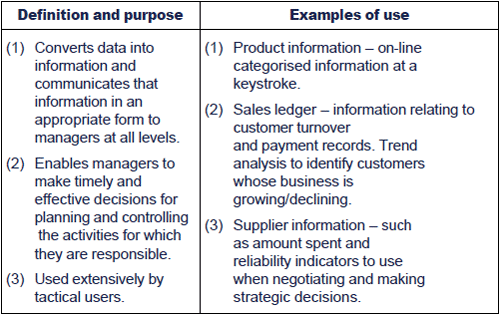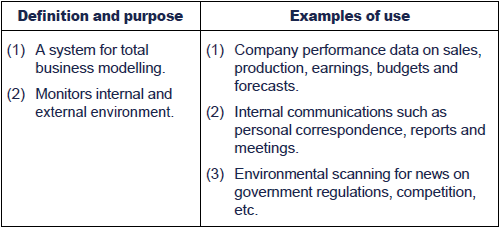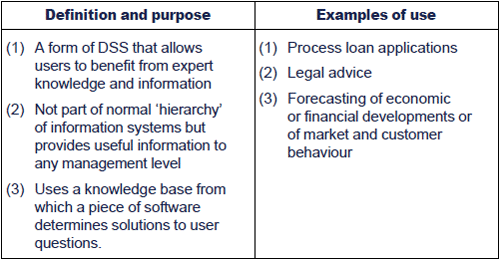Introduction
Management information systems (MIS) provides information to help manage organisations efficiently and effectively.
Information systems (IS)
Deploying information systems in the organisation
Information systems are a combination of planned procedures,suitably designed forms, an appropriate organisation structure and managers who are capable of using the output that is produced to assist them in the administration and use of available resources.
The output from the systems falls into two groups:
- routine reports or transaction documents are those required to conform to business conventions, such as payslips, invoices sent to customers, purchase orders sent to suppliers and works orders sent to the factory, day book listings or standard letters
- management information in the form of reports which are summaries of or extracts from the data which has been processed, e.g. labour cost analyses, sales analyses, stock reports.
The advantages computerisation will bring to a company
Most aspects of our economy, from the music industry to manufacturing, banking, retailing and defence, are now totally dependent on modern information processing systems. Developments in information technology provide companies with new opportunities, e.g.:
- internet
- access to corporate databases
- mobile computing
- improved telecommunication structure.
The value of computer systems in handling and processing business data cannot be underestimated.
Computers have revolutionised information systems for the following reasons:

- Speed - Computers are ideal for dealing with repetitive processes. The limiting factors, for example, in processing a payroll by computer are not the speed of calculation by the computer, but the speed with which data can be input and the speed of the printer at the output.
- Accuracy - In general, computers do not suffer from errors, or lapses of concentration but process data perfectly. Any mistakes that computers make nowadays are not caused by electronic error, but by human error, for example at the input stage, or in designing and programming software.
- Volume - Not only do computers work fast, but they do not need to rest. They can work twenty-four hour days when required. They are therefore able to handle vast volumes of data.
- Complexity - Once subsystems are computerised they can generally function more reliably than human beings. This makes it easier to integrate various subsystems. Computers are therefore able to handle complex information systems efficiently. However, one of the problems with this is that when the computer does fail, there is often a major breakdown in the system, with many personnel unable to perform their work functions.
- Cost - All the above advantages mean that computers have become highly cost-effective providers of information. The process of substituting computers for human beings has revolutionised information-oriented industries such as accountancy, banking and insurance and this process is continuing.
- Presentation - More recently, emphasis has been placed on displaying information in as 'user-friendly' a way as possible.
A strategic resource
Information systems are also seen as a valuable strategic resource which can help an organisation gain competitive advantage, e.g. those instances where the information system:
- links the organisation to customers or suppliers
- creates effective integration of the use of information in a value-adding process
- enables the organisation to develop, produce, market and deliver new products and/or services based on information
- gives senior management information to help develop and implement strategy
Management structure and information requirements
The levels of decision-making and the information required to support it can be analysed into three levels - strategic, tactical and operational.
An organisation's information systems must be organised in such away as to meet the information needs of these various levels of management.
- The strategic level of management requires information from internal and external sources in order to plan the long-term strategies of the organisation. Internal information - both quantitative and qualitative - is usually supplied in a summarised form, often on an ad-hoc basis.
- The tactical level of management requires information and instructions from the strategic level of management together with routine and regular quantitative information from the operational level of management. The information would be in a summarised form, but detailed enough to allow tactical planning of resources and manpower.
- The operational level of management requires information and instructions from the tactical level of management. The operational level is primarily concerned with the day-to-day performance of tasks and most of the information is obtained from internal sources. The information must be detailed and precise.
The following chart outlines the characteristics of information at each of the levels of management/decision-making in an organisation
Typical information used at each of the management levels include:

Information systems used within an organisation
A modern organisation needs a wide range of systems to process,analyse and hold information. We have already noted that the different management decision-making levels within an organisation need different types of information and in this section we look at how the information systems vary accordingly.
There are five main types of information processing system:
Transaction processing systems (TPS)

A transaction processing system gathers source data relating to individual monetary transactions (purchases, sales, costs) and summarises them so that they can be reported on a routine basis. These systems represent the lowest level in an organisation's use of information systems. They are used for routine tasks in which data items or transactions must be processed so that operations can continue.
The function of transaction processing is concerned with recording,processing and communicating data relating to the activities involved in converting input resources into goods and services to meet customers' needs.
Examples of common TPS are the purchase ledger, sales ledger and payroll systems
Management information systems (MIS)

Within most management information systems there are four system types.
- Database systems which process and store information which becomes the organisation's memory.
- Direct control systems which monitor and report on activities such as output levels, sales ledger and credit accounts in arrears.
- Enquiry systems based on databases which provide specific information such as the performance of a department or an employee.
- Support systems which provide computer-based methods and procedures for conducting analyses, forecasts and simulations.
Decision support systems (DSS)

Decision support systems are computer-based systems that help decision-makers confront ill-structured problems through direct interaction with data and analysis models.
A good DSS should have balance among the following three capabilities:
- it should be easy to use to support the interaction with non-technical users
- it should have access to a wide variety of data.
- it should provide modelling and analysis in many ways.
This report could come from a decision support system used by marketing staff in planning corporate entertainment events. It shows areal-time weather forecast for the region in which the event is to beheld
Executive information systems (EIS)

Executive Information Systems (EIS) provide managers with flexible access to information at the tactical and strategic levels, for monitoring operating results and general business conditions. They monitor both the internal and external environment of the company and highlights information that the executive should be made aware of. In some ways they resemble, in outcomes, the DSS, but whereas the DSS provided tools that required significant expertise to use, the EIS is designed to help managers find the information they need whenever they need it, and in the most appropriate format. For both DSS and EIS, the TPS/database will be the source of raw information. The EIS is a high cost facility, and therefore its use is likely to be limited to high level management functions.
Expert systems (ES)

Expert systems hold specialist (expert) knowledge and allow non-experts to interrogate the system for information, advice and recommended decisions.
There are many examples of expert systems in such areas of business as credit control, engineering and recruitment. Even something as simple as the control panel of a photocopier can be considered an expert system, as it allows the operator to diagnose the cause of a machine breakdown and to fix the machine.
They are used widely in the following areas:
- law (e.g. conveyancing)
- taxation (e.g. personal tax)
- banking (e.g. granting credit)
- medicine (e.g. diagnosis of symptoms)
- defence (e.g. aircraft recognition).
Expert systems can be used at a variety of different levels. At the simplest level they can give factual answers to technical questions. At a more complex level they can suggest how a decision should be made,recommending a course of action. In this respect they go further than decision support systems.
|
Created at 10/22/2012 2:58 PM by System Account
(GMT) Greenwich Mean Time : Dublin, Edinburgh, Lisbon, London
|
Last modified at 11/8/2012 11:28 AM by System Account
(GMT) Greenwich Mean Time : Dublin, Edinburgh, Lisbon, London
|
|
|
|
 |
Rating
:
|
 Ratings & Comments
(Click the stars to rate the page) Ratings & Comments
(Click the stars to rate the page)
|
 |
Tags:
|
|